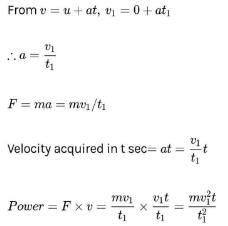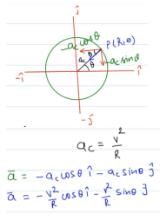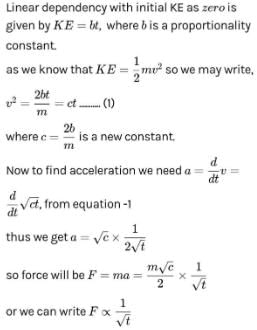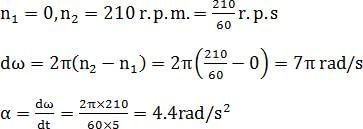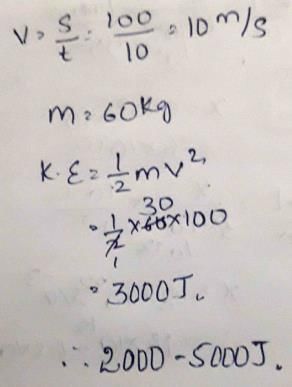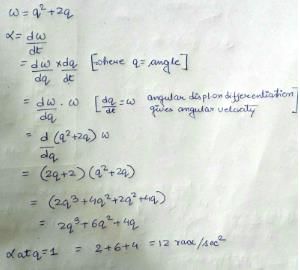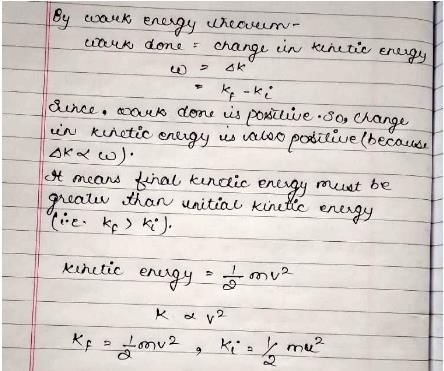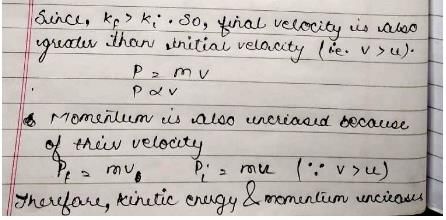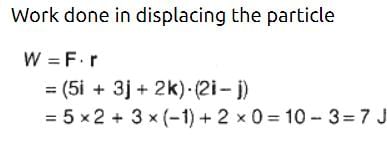All Exams >
NEET >
Topic-wise MCQ Tests for NEET >
All Questions
All questions of Work, Energy and Power for NEET Exam
For what angle between Force and Displacement will the work done be positive?- a)

- b)

- c)

- d)

Correct answer is option 'C'. Can you explain this answer?
For what angle between Force and Displacement will the work done be positive?
a)
b)
c)
d)
|
|
Om Desai answered |
- If a force acting on a body has a component in the opposite direction of displacement, the work done is negative.
- So when a body slides against a rough horizontal surface, its displacement is opposite to that of the force of friction. The work done by the friction is negative.
Work done by gravitational force on a man, in lifting a bucket out of the well by rope tied to the bucket is- a)negative
- b)positive
- c)zero
- d)infinity
Correct answer is option 'A'. Can you explain this answer?
Work done by gravitational force on a man, in lifting a bucket out of the well by rope tied to the bucket is
a)
negative
b)
positive
c)
zero
d)
infinity
|
|
Om Desai answered |
When the man pulls the bucket outside the well the gravitational potential of the man + bucket system increases and hence the work done by the gravitational force is negative.
Two identical balls A and B moving with velocities +0.5 m/s and –0.3 m/s respectively, collide head on elastically. The velocities of the balls A and B after collision, will be, respectively [1991]- a)+0.5 m/s and +0.3 m/s
- b)– 0.3 m/s and +0.5 m/s
- c)+0.3 m/s and 0.5 m/s
- d)–0.5 m/s and +0.3 m/s
Correct answer is option 'B'. Can you explain this answer?
Two identical balls A and B moving with velocities +0.5 m/s and –0.3 m/s respectively, collide head on elastically. The velocities of the balls A and B after collision, will be, respectively [1991]
a)
+0.5 m/s and +0.3 m/s
b)
– 0.3 m/s and +0.5 m/s
c)
+0.3 m/s and 0.5 m/s
d)
–0.5 m/s and +0.3 m/s

|
Kajal Bose answered |
When the identical balls collide head-on, their velocities are exchanged.
Time rate at which work is done by a force is- a)Power
- b)Torque
- c)Centrifugal Force
- d)Acceleration
Correct answer is option 'A'. Can you explain this answer?
Time rate at which work is done by a force is
a)
Power
b)
Torque
c)
Centrifugal Force
d)
Acceleration
|
|
Gaurav Kumar answered |
We know that Work done, W = F.s
where F is force and s is displacement due to that force.
Thus rate of work done is:
where F is force and s is displacement due to that force.
Thus rate of work done is:
dW/dt = d(F.s)/dt
So as F is constant we get,
dW/dt = F.d(s)/dt = F.v = P (Power)
dW/dt = F.d(s)/dt = F.v = P (Power)
There are two bodies X and Y with equal kinetic energy but different masses m and 4m respectively. The ratio of their linear momentum is-- a)1:2
- b)4:1
- c)1:√2
- d)1:4
Correct answer is option 'A'. Can you explain this answer?
There are two bodies X and Y with equal kinetic energy but different masses m and 4m respectively. The ratio of their linear momentum is-
a)
1:2
b)
4:1
c)
1:√2
d)
1:4
|
|
Suresh Iyer answered |
X and Y have equal kinetic energy but their masses are m and 4m respectively.
► 1/2 m1v12 = 1/2 m2v22
► mv12 = 4m * v22
► v1 : v2 = 2 : 1
Hence the ratio of their linear momentum is:
m1v1 : m2v2 = m * 2v : 4m * v = 1 : 2
► 1/2 m1v12 = 1/2 m2v22
► mv12 = 4m * v22
► v1 : v2 = 2 : 1
Hence the ratio of their linear momentum is:
m1v1 : m2v2 = m * 2v : 4m * v = 1 : 2
By how much does kinetic energy increase if the momentum is increased by 20%?- a)55 %
- b)20 %
- c)44 %
- d)60 %
Correct answer is option 'C'. Can you explain this answer?
By how much does kinetic energy increase if the momentum is increased by 20%?
a)
55 %
b)
20 %
c)
44 %
d)
60 %
|
|
Hansa Sharma answered |
The kinetic energy is given by:
KE= p2/2m
So, ΔKE = 2pΔp / 2m = pΔp / m
ΔKE / KE = (pΔp/m) * (2m/p2) = 2Δp / p
Since the momentum p increases by 20%, so the final momentum becomes 1.2p.
Hence, KEfinal = (1.2p)2 / 2m = 1.44p2 / 2m = 1.44KE
So, % change in KE = 44%
ΔKE / KE = (pΔp/m) * (2m/p2) = 2Δp / p
Since the momentum p increases by 20%, so the final momentum becomes 1.2p.
Hence, KEfinal = (1.2p)2 / 2m = 1.44p2 / 2m = 1.44KE
So, % change in KE = 44%
Output of a truck is 4500 J and its efficiency is 50%, the input energy provided to the truck is- a)5000 J
- b)900 J
- c)9000 J
- d)500 J
Correct answer is option 'C'. Can you explain this answer?
Output of a truck is 4500 J and its efficiency is 50%, the input energy provided to the truck is
a)
5000 J
b)
900 J
c)
9000 J
d)
500 J
|
|
Naina Sharma answered |
► η = work output / heat input
► η = 50% = 50/100 = 1/2
► 1/2 = 4500 / Heat input
► Heat input = 9000 J
► η = 50% = 50/100 = 1/2
► 1/2 = 4500 / Heat input
► Heat input = 9000 J
A wheel is at rest. Its angular velocity increases uniformly and becomes 80 radian per second after 5 second. The total angular displacement is :- a)800 Red
- b)400 Red
- c)200 Red
- d)100 Red
Correct answer is option 'C'. Can you explain this answer?
A wheel is at rest. Its angular velocity increases uniformly and becomes 80 radian per second after 5 second. The total angular displacement is :
a)
800 Red
b)
400 Red
c)
200 Red
d)
100 Red
|
|
Arjun Singhania answered |
As stated
if the angular velocity increases uniformly . The angular acceleration must be constant.
Hence the formula
s= ut+ 0.5 a t^2
Where.
u= initial angular velocity
a= angular acceleration (i.e = 80/5=16 rad/s^2)
S= angular displacement
t= time taken
Now.
s= 0 + 0.5 X 16*5*5 = 200
Hence angar displacement = 200 radians
Water falls from a height of 60 m at the rate of 15 kg/s to operate a turbine. The losses due to frictional force are 10% of energy. How much power is generated by the turbine?( g = 10 m/s2) [2008]
- a)8.1 kW
- b)10.2 kW
- c)12.3 kW
- d)7.0 kW
Correct answer is option 'A'. Can you explain this answer?
Water falls from a height of 60 m at the rate of 15 kg/s to operate a turbine. The losses due to frictional force are 10% of energy. How much power is generated by the turbine?( g = 10 m/s2) [2008]
a)
8.1 kW
b)
10.2 kW
c)
12.3 kW
d)
7.0 kW

|
Arnav Iyer answered |
Given, h = 60m, g = 10 ms–2, Rate of flow of water = 15 kg/s
∴ Power of the falling water = 15 kgs–1 × 10 ms–2 × 60 m = 900 watt.
Loss in energy due to friction
Loss in energy due to friction

∴ Power generated by the turbine = ( 9000 – 900) watt = 8100 watt = 8.1 kW
A ball of mass (m) 0.5 kg is attached to the end of a string having length (L) 0.5 m. The ball is rotated on a horizontal circular path about vertical axis. The maximum tension that the string can bear is 324 N. the maximum possible value of angular velocity of ball (in radian/s) is[jee-2011] 
- a)9
- b)18
- c)27
- d)36
Correct answer is option 'D'. Can you explain this answer?
A ball of mass (m) 0.5 kg is attached to the end of a string having length (L) 0.5 m. The ball is rotated on a horizontal circular path about vertical axis. The maximum tension that the string can bear is 324 N. the maximum possible value of angular velocity of ball (in radian/s) is
[jee-2011]
a)
9
b)
18
c)
27
d)
36
|
|
Gaurav Kumar answered |
Forum id- 1557839
We have,
Tsinθ=mrω2
But,
sinθ=Lr
∴ T=mLω2
∴ 324=0.5×0.5×ω2
∴ ω=36 rad/s
We have,
Tsinθ=mrω2
But,
sinθ=Lr
∴ T=mLω2
∴ 324=0.5×0.5×ω2
∴ ω=36 rad/s
A machine gun fires 60 bullets per minute, with a velocity of 700 m/s. If each bullet has a mass of 50g, find the power developed by the gun.
- a)1225 W
- b)12250 W
- c)122.5 W
- d)122 W
Correct answer is option 'B'. Can you explain this answer?
A machine gun fires 60 bullets per minute, with a velocity of 700 m/s. If each bullet has a mass of 50g, find the power developed by the gun.
a)
1225 W
b)
12250 W
c)
122.5 W
d)
122 W
|
|
Tejas Verma answered |
Each bullet will have KE = 1/2 * 0.05 * 700 * 700 = 12250 J
So for 60 bullets the energy given by machine in 60 second = 60 x 12250 J
Hence power developed = Energy / time =60 x12250/60 =12250W
Or power = 12.250 kW.
So for 60 bullets the energy given by machine in 60 second = 60 x 12250 J
Hence power developed = Energy / time =60 x12250/60 =12250W
Or power = 12.250 kW.
A bob of mass M is suspended by a massless string of length L. The horizontal velocity V at position A is just sufficient to make it reach the point B. The angle q atwhich the speed of the bob is half of that at A, satisfies- a)

- b)

- c)

- d)

Correct answer is option 'D'. Can you explain this answer?
A bob of mass M is suspended by a massless string of length L. The horizontal velocity V at position A is just sufficient to make it reach the point B. The angle q at
which the speed of the bob is half of that at A, satisfies
a)
b)
c)
d)
|
|
Neha Sharma answered |
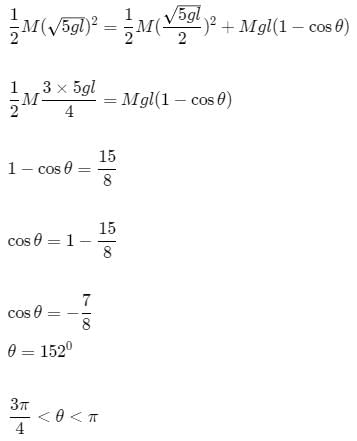
Which of the following is not conserved in inelastic collision?- a)momentum
- b)kinetic energy
- c)both momentum and kinetic energy
- d)neither momentum nor kinetic energ
Correct answer is option 'B'. Can you explain this answer?
Which of the following is not conserved in inelastic collision?
a)
momentum
b)
kinetic energy
c)
both momentum and kinetic energy
d)
neither momentum nor kinetic energ
|
|
Rajesh Gupta answered |
In an inelastic collision, the force of reformation is not equal to the force of deformation and thus some amount of energy is lost. But still as no external force acts upon the system momentum is still conserved.
A bomb of mass 30 kg at rest explodes into two pieces of masses 18 kg and 12 kg. The velocity of 18 kg mass is 6 ms–1. The kinetic energy of the other mass is [2005]- a)324 J
- b)486 J
- c)256 J
- d)524 J
Correct answer is option 'B'. Can you explain this answer?
A bomb of mass 30 kg at rest explodes into two pieces of masses 18 kg and 12 kg. The velocity of 18 kg mass is 6 ms–1. The kinetic energy of the other mass is [2005]
a)
324 J
b)
486 J
c)
256 J
d)
524 J

|
Sarthak Saini answered |
From conservation of linear momentum


Which of the following statement is not related to conservative force?- a)Work done in closed path is zero
- b)Work done is recoverable
- c)Path independent
- d)Path dependent
Correct answer is option 'D'. Can you explain this answer?
Which of the following statement is not related to conservative force?
a)
Work done in closed path is zero
b)
Work done is recoverable
c)
Path independent
d)
Path dependent
|
|
Krishna Iyer answered |
A force is said to be conservative if the work done by or against the force on a body is independent of path followed by the body and depends only on initial and final positions.
Work done by or against the conservative force in moving a particle along a closed path is zero.
Work done by or against the conservative force in moving a particle along a closed path is zero.
Which of the following is not a unit of energy?- a)newton meter
- b)electron volt
- c)joule/meter
- d)kilowatt hour
Correct answer is option 'C'. Can you explain this answer?
Which of the following is not a unit of energy?
a)
newton meter
b)
electron volt
c)
joule/meter
d)
kilowatt hour

|
Gargey Dudhe answered |
C is correct option because energy The joule ( symbol: J) is a derived unit of energy in the International System of Units. It is equal to the energy transferred to (or work done on) an object when a force of one newton acts on that object in the direction of its motion through a distance of one metre (1 newton metreor N⋅m). pls upvote and follow me.
In an elastic collision in one dimension if a body A collides against the body B of equal mass at rest, then the body A will- a)moves with the same velocity but in opposite direction
- b)move with twice its initial velocity
- c)moves with the same velocity in the same direction
- d)come to rest.
Correct answer is option 'D'. Can you explain this answer?
In an elastic collision in one dimension if a body A collides against the body B of equal mass at rest, then the body A will
a)
moves with the same velocity but in opposite direction
b)
move with twice its initial velocity
c)
moves with the same velocity in the same direction
d)
come to rest.
|
|
Lavanya Menon answered |
Since collision is elastic and mass is same then after velocity exchange A body will stop and B will start moving with A's velocity in the same direction.
A uniform chain of length 2 m is kept on a table such that a length of 60 cm hangs freely from the edge of the table. The total mass of the chain is 4 kg. What is the work done in pulling the entire chain on the table?[AIEEE 2004]- a)7.2 J
- b) 3.6 J
- c)120 J
- d)1200 J
Correct answer is option 'B'. Can you explain this answer?
A uniform chain of length 2 m is kept on a table such that a length of 60 cm hangs freely from the edge of the table. The total mass of the chain is 4 kg. What is the work done in pulling the entire chain on the table?
[AIEEE 2004]
a)
7.2 J
b)
3.6 J
c)
120 J
d)
1200 J
|
|
Geetika Shah answered |
The center of mass of the hanging part is at 0.3m from table
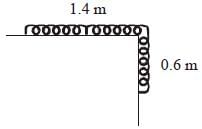
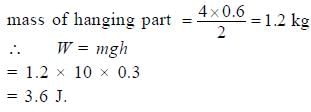


A 2 kg block slides on a horizontal floor with a speed of 4 m/s. It strikes a uncompressed spring, and compresses it till the block is motionless. The kinetic friction force is 15 N and spring constant is 10000 N/m. The spring compresses by[AIEEE 2007]- a)5.5 cm
- b)2.5 cm
- c)11.0 cm
- d)8.5 cm
Correct answer is option 'A'. Can you explain this answer?
A 2 kg block slides on a horizontal floor with a speed of 4 m/s. It strikes a uncompressed spring, and compresses it till the block is motionless. The kinetic friction force is 15 N and spring constant is 10000 N/m. The spring compresses by
[AIEEE 2007]
a)
5.5 cm
b)
2.5 cm
c)
11.0 cm
d)
8.5 cm
|
|
Om Desai answered |
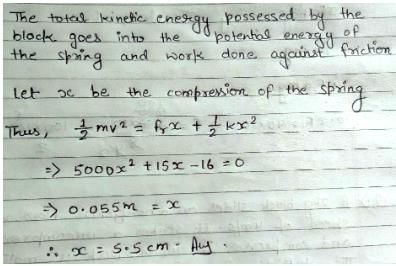
Two moving particle P and Q are 10 m apart at a certain instant. The velocity of P is 8m/s making an angle 30° with the line joining P and Q and that of Q is 6m/s making an angle 30° with PQ as shown in the figure. Then angular velocity of P with respect to Q is 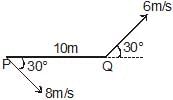
- a)Zero
- b)0.1 rad/sec
- c)0.4 rad/sec
- d)0.7 rad sec
Correct answer is option 'D'. Can you explain this answer?
Two moving particle P and Q are 10 m apart at a certain instant. The velocity of P is 8m/s making an angle 30° with the line joining P and Q and that of Q is 6m/s making an angle 30° with PQ as shown in the figure. Then angular velocity of P with respect to Q is
a)
Zero
b)
0.1 rad/sec
c)
0.4 rad/sec
d)
0.7 rad sec
|
|
Krishna Iyer answered |

A machine, in an amusement park, consists of a cage at the end of one arm, hinged at O. The cage revolves along a vertical circle of radius r (ABCDEFGH) about its hinge O, at constant linear speedv =  . The cage is so attached that the man of weight `w' standing on a weighing machine, inside the cage, is always vertical. Then which of the following is correct
. The cage is so attached that the man of weight `w' standing on a weighing machine, inside the cage, is always vertical. Then which of the following is correct
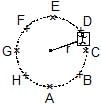
- a)The reading of his weight on the machine is the same at all positions
- b)The weight reading at A is greater than the weight reading at E by 2 w.
- c)The weight reading at G = w
- d)The ratio of the weight reading at E to that at A=0
- e)The ratio of the weight reading at A to that at C=2
Correct answer is option 'B,C,D,E'. Can you explain this answer?
A machine, in an amusement park, consists of a cage at the end of one arm, hinged at O. The cage revolves along a vertical circle of radius r (ABCDEFGH) about its hinge O, at constant linear speed
v =  . The cage is so attached that the man of weight `w' standing on a weighing machine, inside the cage, is always vertical. Then which of the following is correct
. The cage is so attached that the man of weight `w' standing on a weighing machine, inside the cage, is always vertical. Then which of the following is correct

a)
The reading of his weight on the machine is the same at all positions
b)
The weight reading at A is greater than the weight reading at E by 2 w.
c)
The weight reading at G = w
d)
The ratio of the weight reading at E to that at A=0
e)
The ratio of the weight reading at A to that at C=2

|
Crafty Classes answered |
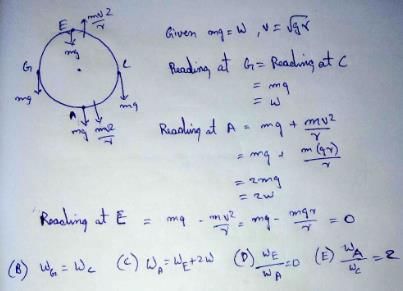
No work is done by a force on an object if- a)The force is always perpendicular to its velocity
- b)The force is always perpendicular to its acceleration
- c)The object is stationary but the point of application of the force moves on the object.
- d)The object moves in such a way that the point of application of the force remains fixed.
Correct answer is option 'A,B'. Can you explain this answer?
No work is done by a force on an object if
a)
The force is always perpendicular to its velocity
b)
The force is always perpendicular to its acceleration
c)
The object is stationary but the point of application of the force moves on the object.
d)
The object moves in such a way that the point of application of the force remains fixed.
|
|
Krishna Iyer answered |
Work done = f.ds
So on perpendicular application for product becomes zero so no work is done
So on perpendicular application for product becomes zero so no work is done
When a ball is allowed to fall from a height of 20 m, 40% of its energy is lost due to impact. After one impact the ball will go up to a height of- a)12 m
- b)15 m
- c)8 m
- d)10 m
Correct answer is option 'A'. Can you explain this answer?
When a ball is allowed to fall from a height of 20 m, 40% of its energy is lost due to impact. After one impact the ball will go up to a height of
a)
12 m
b)
15 m
c)
8 m
d)
10 m
|
|
Lavanya Menon answered |
Before the impact the KE was ½ x m x (2g x 20) = 20mg
And let say v be the velocity after impact and for height h, v2= 2gh
Thus KE = ½ mv2 = ½m2gh = ⅗ x 20mg
Thus we get mgh = 12mg
thus h = 12 m
And let say v be the velocity after impact and for height h, v2= 2gh
Thus KE = ½ mv2 = ½m2gh = ⅗ x 20mg
Thus we get mgh = 12mg
thus h = 12 m
Frictional force is an example of- a)ectrostatic force
- b)Non conservative force
- c)conservative force
- d)nuclear force
Correct answer is option 'B'. Can you explain this answer?
Frictional force is an example of
a)
ectrostatic force
b)
Non conservative force
c)
conservative force
d)
nuclear force
|
|
Om Desai answered |
The friction is the phenomena that defines that there is a resistance which is present there between the two surfaces. This friction is applied tangentially to the surfaces in contact. Thus the main thing is that the forces on both of the surfaces act tangential to each other.
When conservative force does positive work on a body, the potential energy of the body:- a)increases
- b)decreases
- c)remains unaltered
- d)there is no relationship between force and potential energy
Correct answer is option 'B'. Can you explain this answer?
When conservative force does positive work on a body, the potential energy of the body:
a)
increases
b)
decreases
c)
remains unaltered
d)
there is no relationship between force and potential energy
|
|
Suresh Iyer answered |
We have a relation between potential energy and work done: 
The negative sign just shows the inverse relation between potential energy and work done by conservative force.

The negative sign just shows the inverse relation between potential energy and work done by conservative force.
A rigid body of mass m is moving in a circle of radius r with a constant speed v. The force on the body is  and is directed towards the centre. What is the work done by this force in moving the body over half the cirumference of the circle.
and is directed towards the centre. What is the work done by this force in moving the body over half the cirumference of the circle.- a)

- b) Zero
- c)

- d)

Correct answer is option 'B'. Can you explain this answer?
A rigid body of mass m is moving in a circle of radius r with a constant speed v. The force on the body is  and is directed towards the centre. What is the work done by this force in moving the body over half the cirumference of the circle.
and is directed towards the centre. What is the work done by this force in moving the body over half the cirumference of the circle.
a)
b)
Zero
c)
d)
|
|
Lavanya Menon answered |
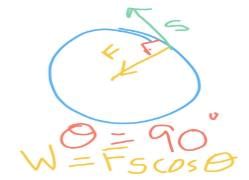
Force = mv2/r ( towards the centre )
displacement = 2r
Work done = FScosѲ
here ,
= mv2/r × s × cos 90
= 0 answer.
The block of mass M moving on the frictionless horizontal surface collides with the spring of spring constant k and compresses it by length L. The maximum momentum of the block after collision is[AIEEE 2005] 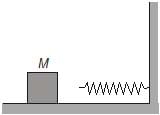
- a)

- b)

- c) zero
- d)

Correct answer is option 'A'. Can you explain this answer?
The block of mass M moving on the frictionless horizontal surface collides with the spring of spring constant k and compresses it by length L. The maximum momentum of the block after collision is
[AIEEE 2005]
a)
b)
c)
zero
d)
|
|
Raghav Bansal answered |

The potential energy of a system increases if work is done [2011]- a)upon the system by a n on conser vative force
- b)upon the system by a conservative force
- c)by the system against a non conservative force
- d)by the system against a conservative force
Correct answer is option 'D'. Can you explain this answer?
The potential energy of a system increases if work is done [2011]
a)
upon the system by a n on conser vative force
b)
upon the system by a conservative force
c)
by the system against a non conservative force
d)
by the system against a conservative force
|
|
Avantika Kumar answered |
Explanation:
When work is done on a system against a conservative force, the potential energy of the system increases.
- Conservative Force: A force is said to be conservative if the work done by the force on a particle moving from one point to another depends only on the initial and final positions of the particle and not on the path followed by the particle.
- Potential Energy: Potential energy is the energy possessed by a system due to the relative positions of its components. It is a scalar quantity and is measured in joules (J).
In the given options, only option D mentions work done by the system against a conservative force, which is the correct answer.
When a system does work against a conservative force, the energy is stored in the system as potential energy. This potential energy can be released later when the system returns to its original position or configuration.
For example, when a spring is compressed by an external force, the system stores potential energy. When the external force is removed, the spring returns to its original position and releases the stored potential energy.
Hence, the potential energy of a system increases when work is done by the system against a conservative force.
When work is done on a system against a conservative force, the potential energy of the system increases.
- Conservative Force: A force is said to be conservative if the work done by the force on a particle moving from one point to another depends only on the initial and final positions of the particle and not on the path followed by the particle.
- Potential Energy: Potential energy is the energy possessed by a system due to the relative positions of its components. It is a scalar quantity and is measured in joules (J).
In the given options, only option D mentions work done by the system against a conservative force, which is the correct answer.
When a system does work against a conservative force, the energy is stored in the system as potential energy. This potential energy can be released later when the system returns to its original position or configuration.
For example, when a spring is compressed by an external force, the system stores potential energy. When the external force is removed, the spring returns to its original position and releases the stored potential energy.
Hence, the potential energy of a system increases when work is done by the system against a conservative force.
If the kinetic energy of a particle is increased by 300%, the momentum of the particle will increase by[2002]- a)20%
- b)200%
- c)100%
- d)50%
Correct answer is option 'C'. Can you explain this answer?
If the kinetic energy of a particle is increased by 300%, the momentum of the particle will increase by[2002]
a)
20%
b)
200%
c)
100%
d)
50%

|
Pooja Saha answered |
New K.E., E' = 4E



[on substrating 1 in both sides.]

Two cylindrical vessels of equal cross-sectional area 16 cm2 contain water up to heights 100 cm and 150 cm, respectively. The vessels are interconnected so that the water levels in them become equal. The work done by the force of gravity during the process is: [Take density of water = 103 kg/m3 and g = 10 ms-2]
- a)0.25 J
- b)12 J
- c)8 J
- d)1 J
Correct answer is option 'D'. Can you explain this answer?
Two cylindrical vessels of equal cross-sectional area 16 cm2 contain water up to heights 100 cm and 150 cm, respectively. The vessels are interconnected so that the water levels in them become equal. The work done by the force of gravity during the process is: [Take density of water = 103 kg/m3 and g = 10 ms-2]
a)
0.25 J
b)
12 J
c)
8 J
d)
1 J
|
|
Rajeev Saxena answered |

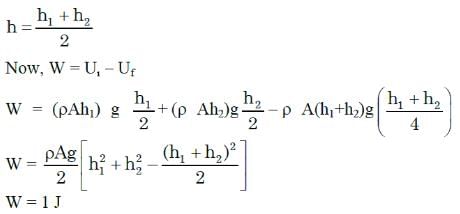
Which of the following statements is false:- a)kinetic energy is positiv
- b)potential energy is positive
- c)kinetic energy is negative
- d)potential energy is negative
Correct answer is option 'C'. Can you explain this answer?
Which of the following statements is false:
a)
kinetic energy is positiv
b)
potential energy is positive
c)
kinetic energy is negative
d)
potential energy is negative

|
Aiims answered |
K.E never negative as velocity negative then its square becomes it positive.
Select the odd one out- a)Viscous force
- b)Frictional force
- c)Electrostatic force
- d)Air-resistance
Correct answer is option 'C'. Can you explain this answer?
Select the odd one out
a)
Viscous force
b)
Frictional force
c)
Electrostatic force
d)
Air-resistance
|
|
Pranav Datta answered |
The odd one out among the given options is option 'C', which represents the Electrostatic force.
**Viscous Force:**
- Viscous force refers to the resistance that a fluid (liquid or gas) exerts on an object moving through it.
- It is a type of frictional force that opposes the relative motion of the object and the fluid.
- Viscous force is responsible for phenomena like drag experienced by objects moving through a fluid medium.
- Examples of viscous force include the resistance experienced by a car moving through air or a boat moving through water.
**Frictional Force:**
- Frictional force is the force that opposes the motion or attempted motion of an object past another object with which it is in contact.
- It arises due to the roughness or irregularities present on the surfaces in contact.
- Frictional force plays a crucial role in our daily lives, such as walking, driving a car, or holding objects.
- It can be both advantageous (e.g., walking) and disadvantageous (e.g., wearing out of machine parts).
**Electrostatic Force:**
- Electrostatic force is the force of attraction or repulsion between charged objects.
- It arises due to the electric charge carried by the objects.
- Objects with the same charges repel each other, while objects with opposite charges attract each other.
- Electrostatic force is responsible for various phenomena such as the attraction of clothes after being dried in a dryer or the repulsion of two magnets.
**Air-Resistance:**
- Air resistance, also known as drag, is a force that opposes the motion of an object through the air.
- It is caused by the collision of air molecules with the object in motion.
- Air resistance depends on factors such as the shape and size of the object, the speed of motion, and the density of the air.
- It affects objects moving through the air, like a falling parachute or a moving car.
**Explanation:**
The odd one out is electrostatic force because it is the only option that does not involve the interaction between objects in motion or with a fluid medium. Electrostatic force is related to the interaction between charged objects, whereas the other three forces (viscous force, frictional force, and air resistance) are associated with the motion of objects through a medium (fluid or air).
**Viscous Force:**
- Viscous force refers to the resistance that a fluid (liquid or gas) exerts on an object moving through it.
- It is a type of frictional force that opposes the relative motion of the object and the fluid.
- Viscous force is responsible for phenomena like drag experienced by objects moving through a fluid medium.
- Examples of viscous force include the resistance experienced by a car moving through air or a boat moving through water.
**Frictional Force:**
- Frictional force is the force that opposes the motion or attempted motion of an object past another object with which it is in contact.
- It arises due to the roughness or irregularities present on the surfaces in contact.
- Frictional force plays a crucial role in our daily lives, such as walking, driving a car, or holding objects.
- It can be both advantageous (e.g., walking) and disadvantageous (e.g., wearing out of machine parts).
**Electrostatic Force:**
- Electrostatic force is the force of attraction or repulsion between charged objects.
- It arises due to the electric charge carried by the objects.
- Objects with the same charges repel each other, while objects with opposite charges attract each other.
- Electrostatic force is responsible for various phenomena such as the attraction of clothes after being dried in a dryer or the repulsion of two magnets.
**Air-Resistance:**
- Air resistance, also known as drag, is a force that opposes the motion of an object through the air.
- It is caused by the collision of air molecules with the object in motion.
- Air resistance depends on factors such as the shape and size of the object, the speed of motion, and the density of the air.
- It affects objects moving through the air, like a falling parachute or a moving car.
**Explanation:**
The odd one out is electrostatic force because it is the only option that does not involve the interaction between objects in motion or with a fluid medium. Electrostatic force is related to the interaction between charged objects, whereas the other three forces (viscous force, frictional force, and air resistance) are associated with the motion of objects through a medium (fluid or air).
A bomb of mass 4 kg explodes in air into two pieces of masses 3 kg and 1 kg. The smaller mass goes at a speed of 90 m/s. The total energy imparted to two fragments is.- a)2.4 kj
- b)5.4 kj
- c)5.9 kJ
- d)3.8 kJ
Correct answer is option 'B'. Can you explain this answer?
A bomb of mass 4 kg explodes in air into two pieces of masses 3 kg and 1 kg. The smaller mass goes at a speed of 90 m/s. The total energy imparted to two fragments is.
a)
2.4 kj
b)
5.4 kj
c)
5.9 kJ
d)
3.8 kJ
|
|
Raghav Bansal answered |
By conservation of momentum we get the speed of the bigger part let say, v = 1 x90 / 3
Hence we get v = 30
Thus the total KE of the system after collision is ½ (3 X 900 + 1 X 8100)
Thus KE = ½ (10800) = 5400
Now if we apply WET to the system, as no external force has acted upon it, we get
W = ΔKE
= 5400 - 0
= 5.4 kJ
Hence we get v = 30
Thus the total KE of the system after collision is ½ (3 X 900 + 1 X 8100)
Thus KE = ½ (10800) = 5400
Now if we apply WET to the system, as no external force has acted upon it, we get
W = ΔKE
= 5400 - 0
= 5.4 kJ
A body is moved along a straight line by a machine delivering a constant power. The distance moved by the body in time t is proportional to[AIEEE 2003]- a) t3/4
- b)t3/2
- c) t1/4
- d) t1/2
Correct answer is option 'B'. Can you explain this answer?
A body is moved along a straight line by a machine delivering a constant power. The distance moved by the body in time t is proportional to
[AIEEE 2003]
a)
t3/4
b)
t3/2
c)
t1/4
d)
t1/2
|
|
Gaurav Kumar answered |
P= fv
P = mav
p = mdv/dt.v
p.dt/m = v.dv ( integration from 0-t)
pt/m = v²/2
v = √(2pt/m)
ds/dt = t½dt
s = t3/2
P = mav
p = mdv/dt.v
p.dt/m = v.dv ( integration from 0-t)
pt/m = v²/2
v = √(2pt/m)
ds/dt = t½dt
s = t3/2
A bomb at rest on a horizontal frictionless surface explodes and breaks into three pieces that fly apart horizontally as shown below. Select all of the following statements that must be true after the bomb has exploded.1. The total kinetic energy of the bomb fragments is the same as that of the bomb before explosion.
2. The total momentum of the bomb fragments is the same as that of the bomb before explosion.
3. The total momentum of all the bomb fragments together is zero.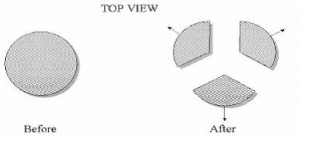
- a)1,2 and 3
- b)1 only
- c)3 only
- d)2 only
Correct answer is option 'C'. Can you explain this answer?
A bomb at rest on a horizontal frictionless surface explodes and breaks into three pieces that fly apart horizontally as shown below. Select all of the following statements that must be true after the bomb has exploded.
1. The total kinetic energy of the bomb fragments is the same as that of the bomb before explosion.
2. The total momentum of the bomb fragments is the same as that of the bomb before explosion.
3. The total momentum of all the bomb fragments together is zero.
2. The total momentum of the bomb fragments is the same as that of the bomb before explosion.
3. The total momentum of all the bomb fragments together is zero.
a)
1,2 and 3
b)
1 only
c)
3 only
d)
2 only
|
|
Naina Sharma answered |
So as no external force acts upon the system, we can say that momentum of the system remains conserved but as an internal force acts that explodes the bomb, the KE of the system is never conserved. But every fragment has some non zero momentum while the bomb initially has zero momentum.
For a conservative force, F is equal to- a)

- b)

- c)

- d)

Correct answer is option 'C'. Can you explain this answer?
For a conservative force, F is equal to
a)
b)
c)
d)
|
|
Pooja Shah answered |
Potential energy at a point is defined in terms the amount of work done, which is defined in terms of force and thus we get potential as an integral of force applied over some position x. Hence F(x) = -dU(x) / dx which is the differentiation of potential energy wrt position.
If a force acts perpendicular to the direction of motion of a body, what is the amount of work done?- a)Infinity
- b)Constant
- c)Zero
- d)sinθ
Correct answer is option 'C'. Can you explain this answer?
If a force acts perpendicular to the direction of motion of a body, what is the amount of work done?
a)
Infinity
b)
Constant
c)
Zero
d)
sinθ
|
|
Anjali Sharma answered |
If a force acts perpendicular to the direction of a body, the amount of work done is zero because there is no displacement in the direction of a force.
A 0.5 kg ball moving with speed of 12 m/s strikes a hard wall at an angle of 30° with the wall. It is reflected with the same speed and at the same angle. If the ball is in contact with the wall for 0.25 seconds, the average force acting on the wall is[2006]
- a)24 N
- b)12 N
- c)96 N
- d)48 N
Correct answer is option 'A'. Can you explain this answer?
A 0.5 kg ball moving with speed of 12 m/s strikes a hard wall at an angle of 30° with the wall. It is reflected with the same speed and at the same angle. If the ball is in contact with the wall for 0.25 seconds, the average force acting on the wall is[2006]

a)
24 N
b)
12 N
c)
96 N
d)
48 N

|
Ias Masters answered |
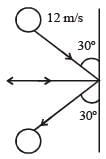
Resolving the velocities in vertical and horizontal directions, resolved parts of first velocity

v cosθ perpendicular to the wall and v sinθ parallel to the wall. In the second case, they are –v sinθ & v cosθ respectively. Here, –ve sign is because direction is opposite to the earlier ones. So we see a net change in velocity perpendicular to way = v sinθ – (–v sinθ) = 2v sinθ
This change has occured in 0.25 sec, so, rate of change of velocity
This change has occured in 0.25 sec, so, rate of change of velocity


Thus, acceleration a = 48 m/sec2
Force applied = m . a = 0.5 × 48 = 24 N
The minimum velocity (in ms_1) with which a car driver must traverse a flat curve of radius 150 m and coefficient of friction 0.6 to avoid skidding is [AIEEE 2002]- a)60
- b)30
- c)15
- d)25
Correct answer is option 'B'. Can you explain this answer?
The minimum velocity (in ms_1) with which a car driver must traverse a flat curve of radius 150 m and coefficient of friction 0.6 to avoid skidding is [AIEEE 2002]
a)
60
b)
30
c)
15
d)
25
|
|
Yash Ghoshal answered |
**Given Data:**
Radius of the curve (r) = 150 m
Coefficient of friction (μ) = 0.6
**To Find:**
Minimum velocity (v) to avoid skidding
**Explanation:**
When a car takes a turn on a curved road, it experiences a centripetal force that keeps it moving in a circular path. This force is provided by the friction between the tires and the road surface. If the velocity of the car is too high, the friction force may not be sufficient to keep the car on the curve, resulting in skidding.
To find the minimum velocity required to avoid skidding, we need to determine the maximum value of the centripetal force that the friction force can provide.
**Step 1:**
The maximum friction force (f) that can be provided is given by the equation:
f = μN
where N is the normal force, which is equal to the weight of the car (mg).
**Step 2:**
The centripetal force (Fc) required to keep the car moving in a circular path is given by the equation:
Fc = mv²/r
where m is the mass of the car and v is its velocity.
**Step 3:**
To avoid skidding, the maximum friction force (f) should be equal to the centripetal force (Fc):
μN = mv²/r
**Step 4:**
Substituting the value of N and rearranging the equation, we get:
μmg = mv²/r
v² = μgr
v = √(μgr)
**Step 5:**
Substituting the given values of μ and r, we can calculate the minimum velocity:
v = √(0.6 * 9.8 * 150)
v = √(88.2)
v ≈ 9.4 m/s
Therefore, the minimum velocity required to avoid skidding is approximately 9.4 m/s.
**Conclusion:**
The correct option is (b) 30 m/s.
Radius of the curve (r) = 150 m
Coefficient of friction (μ) = 0.6
**To Find:**
Minimum velocity (v) to avoid skidding
**Explanation:**
When a car takes a turn on a curved road, it experiences a centripetal force that keeps it moving in a circular path. This force is provided by the friction between the tires and the road surface. If the velocity of the car is too high, the friction force may not be sufficient to keep the car on the curve, resulting in skidding.
To find the minimum velocity required to avoid skidding, we need to determine the maximum value of the centripetal force that the friction force can provide.
**Step 1:**
The maximum friction force (f) that can be provided is given by the equation:
f = μN
where N is the normal force, which is equal to the weight of the car (mg).
**Step 2:**
The centripetal force (Fc) required to keep the car moving in a circular path is given by the equation:
Fc = mv²/r
where m is the mass of the car and v is its velocity.
**Step 3:**
To avoid skidding, the maximum friction force (f) should be equal to the centripetal force (Fc):
μN = mv²/r
**Step 4:**
Substituting the value of N and rearranging the equation, we get:
μmg = mv²/r
v² = μgr
v = √(μgr)
**Step 5:**
Substituting the given values of μ and r, we can calculate the minimum velocity:
v = √(0.6 * 9.8 * 150)
v = √(88.2)
v ≈ 9.4 m/s
Therefore, the minimum velocity required to avoid skidding is approximately 9.4 m/s.
**Conclusion:**
The correct option is (b) 30 m/s.
A shell of mass 200 gm is ejected from a gun of mass 4 kg by an explosion that generates 1.05 kJ of energy. The initial velocity of the shell is:- a)100 ms–1
- b)80 ms–1 [2008]
- c)40 ms–1
- d)120 ms–1
Correct answer is option 'A'. Can you explain this answer?
A shell of mass 200 gm is ejected from a gun of mass 4 kg by an explosion that generates 1.05 kJ of energy. The initial velocity of the shell is:
a)
100 ms–1
b)
80 ms–1 [2008]
c)
40 ms–1
d)
120 ms–1
|
|
Rajeev Saxena answered |
Solution: Option A is correct option.
Explanation is given as follows.
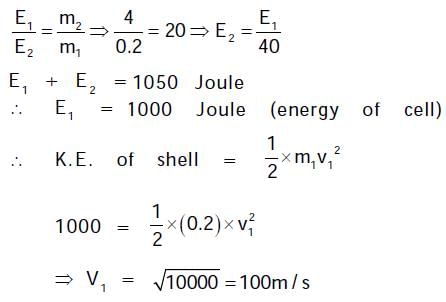
A light inextensible string that goes over a smooth fixed pulley as shown in the figure connects two blocks of masses 0.36 kg and 0.72 kg. Taking g = 10 m/s2, find the work done (in joules) by the string on the block of mass 0.36 kg during the first second after the system is released from rest.
 Correct answer is '8 Joules'. Can you explain this answer?
Correct answer is '8 Joules'. Can you explain this answer?
A light inextensible string that goes over a smooth fixed pulley as shown in the figure connects two blocks of masses 0.36 kg and 0.72 kg. Taking g = 10 m/s2, find the work done (in joules) by the string on the block of mass 0.36 kg during the first second after the system is released from rest.

|
|
Geetika Shah answered |
2mg − T = (2m)a
T − mg = ma
⇒ a = g/3
T = 4mg/3
w = T × s
= T × 1/2at2
= 4/3mg * 1/2 * g/3 * 12
= 200/9 * 0.36
= 8 Joules
T − mg = ma
⇒ a = g/3
T = 4mg/3
w = T × s
= T × 1/2at2
= 4/3mg * 1/2 * g/3 * 12
= 200/9 * 0.36
= 8 Joules
Chapter doubts & questions for Work, Energy and Power - Topic-wise MCQ Tests for NEET 2025 is part of NEET exam preparation. The chapters have been prepared according to the NEET exam syllabus. The Chapter doubts & questions, notes, tests & MCQs are made for NEET 2025 Exam. Find important definitions, questions, notes, meanings, examples, exercises, MCQs and online tests here.
Chapter doubts & questions of Work, Energy and Power - Topic-wise MCQ Tests for NEET in English & Hindi are available as part of NEET exam.
Download more important topics, notes, lectures and mock test series for NEET Exam by signing up for free.

Contact Support
Our team is online on weekdays between 10 AM - 7 PM
Typical reply within 3 hours
|
Free Exam Preparation
at your Fingertips!
Access Free Study Material - Test Series, Structured Courses, Free Videos & Study Notes and Prepare for Your Exam With Ease

 Join the 10M+ students on EduRev
Join the 10M+ students on EduRev
|

|
Create your account for free
OR
Forgot Password
OR
Signup to see your scores
go up within 7 days!
Access 1000+ FREE Docs, Videos and Tests
Takes less than 10 seconds to signup
